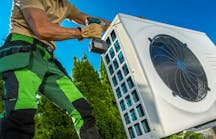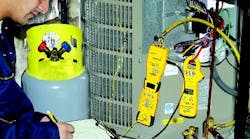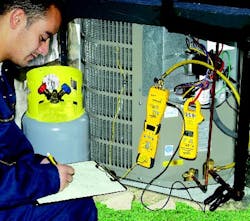UPDATED WITH VIDEO FOLLOWING ARTICLE
As energy costs increase and air conditioning system efficiency becomes more critical, the need for accurate superheat measurements becomes more important.Unfortunately, many technicians take shortcuts when it comes to performing their superheat calculations. Some technicians, under pressure to hurry to the next job, speed the process by making assumptions without taking measurements, or take quick measurements with inadequate instrumentation.
Bill Brown, HVAC instructor at Brownson Technical School, Anaheim, CA, gives this example: "Instead of measuring suction line temperature, some technicians will wrap their bare hand around the pipe and judge by feel. The theory is that if the line is as cold as good cold beer, the system is charged. Unfortunately, that's just not accurate, and we do everything we can to dis-courage this kind of sloppiness."
The results of these "guesstimates" are overcharged or undercharged systems that burn power and operate below optimum levels. In some cases, poor superheat calculations can lead to compressor burnout.
To determine the best way to measure super-heat, we asked some HVAC instructors how they taught superheat, and what instruments they recommend to make taking superheat measurements faster and easier.
Defining Superheat
Superheat is defined as the difference between the temperature at which the refrigerant boils at the given pressure in the evaporator, and the temperature of the refrigerant gas as it leaves the evaporator. In essence, it's how much extra temperature the refrigerant picks up after it has boiled. In a worst-case scenario with an over-charged system and a low indoor heat load, the refrigerant in the evaporator remains in liquid form in the coil and moves into the compressor as a liquid, quickly destroying it.A distinction must be made between systems that employ a thermostatic expansion valve (TXV) and those that have a fixed restrictor/flow-rater. In a properly adjusted system, the TXV controls the flow of refrigerant to ensure superheat is always within a certain range regardless of the condition.
Most problems with superheat occur on fixed restrictor systems. In a well-tuned system, the actual (or measured) superheat varies with the load. The higher the load, the sooner the refrigerant turns into a gas, the more heat it picks up after it evaporates, and the higher the superheat. The lower the load, the later the refrigerant evaporates in the evaporator coil, the less heat is picked up after evaporation, and the lower the superheat.
Target Superheat vs. Actual Superheat
Using superheat measurements to determine the correct refrigerant charge is not that difficult, and the savings in energy and potential repairs are significant.There are only four measurements to take: two to determine the target super-heat and two to determine the actual superheat.
For target superheat, the two measurements are outdoor dry bulb temperature and indoor wet bulb temperature.
For actual superheat, the measurements are boiling/saturation point and suction line temperature.
1. First, determine the target superheat. To do this, take the outdoor air temperature from the air that is going into the condenser coil. Then, determine the wet bulb temperature from in front of the indoor return grille, or better yet, just in front of the evaporator coil.
"The dry bulb temperature is obvious," says Les Haddix, an HVAC instructor at Sequoia Institute, Fremont, CA. "However, many technicians think that wet bulb refers only to indoor comfort. In reality, it's very important in determining the right superheat.
"One of the shortcuts a lot of technicians use is to assume a relative humidity of 50% when determining super-heat. But that's just the system's design parameter. If the relative humidity is higher than that and the technician assumes 50%, the tech will overcharge the system. If the humidity is lower, he'll undercharge."
Armed with these two measurements, refer to the manufacturer's display chart supplied with the unit, usually with wet bulb temperature across the top and dry bulb along the side. The target superheat is displayed where the two intersect.
If the actual superheat is lower than the target superheat, recover refrigerant. If it's higher, add refrigerant. Let the system stabilize, and check again after adding or removing refrigerant.
2. After you've determined the target superheat, you need to determine what the superheat actually is. To determine the actual superheat, you need only two more numbers: The boiling point (saturation point) of the refrigerant in the evaporator (at that pressure), and the suction line temperature.
The boiling point is easy. "The technician can measure the pressure at the condensing unit suction port with a pressure gauge, and in most cases read the boiling point right on the gauge," notes Rob Featherstone, HVAC instructor at Oakland Community College in Auburn Hills, MI. "If the boiling point for the refrigerant you're working with isn't on the gauge, you can look it up on a pressure temperature chart."
To determine the temperature of the refrigerant in the suction line pipe, all you need to do is measure the temperature of the pipe itself within 6-in. of the suction valve.
When you know the boiling point and the suction line temperature, subtract the boiling point located on the gauge or chart from the suction line temperature to get the actual superheat. This is the increase in temperature of the refrigerant gas after it has evaporated.
Once you know the actual superheat and the target superheat, compare them to determine if the system is properly charged. If the actual superheat is lower than the target superheat, recover refrigerant; if it's higher, add refrigerant. Just be sure to always let the system stabilize, and check again after adding or subtracting refrigerant.
Testing Challenges
Unfortunately, as many technicians can attest, it sounds a lot easier than it is. The problem is the three temperature measurements. They're not as easy to take as it would seem.For example, while outdoor dry bulb is the most obvious and easiest super-heat measurement to take, temperatures can vary considerably in the area around the condenser.
"We used to use an analog thermometer in class," says Featherstone. "But it took too long to get the right reading and it was a chore to hold it in position. We started using a stick meter with a K-type thermocouple and got the job done faster and more accurately."
With some K-type thermocouple thermometers, there is a temperature reference junction inside the meter (the "cold junction") that is monitored by a thermometer inside the meter.
Both the reference junction and the thermometer need to be at the same temperature to ensure an accurate reading. Some meters employ an adapter, with the reference junction in the adapter, not in the meter, and not thermally close to the thermometer inside the meter. Any difference in temperature between the external reference junction in the adapter and the internal thermometer inside the meter will show up as an error.
By simply holding this adapter in your hand, you can alter the reading that the multimeter displays. And be aware that if you take a warm adapter from your pocket and put it in a cold meter from the truck, it will be several minutes before you can get an accurate reading.
Indoor wet bulb temperature measurement also presents a problem. Technical articles, manuals, and educational texts suggest technicians use such things as moistened toilet tissue and paper napkins wrapped around the bead. This nuisance factor is one of the reasons some techs take a short cut here, and simply assume a relative humidity of 50%.
To make it easier to take wet bulb temperatures, there are K-type thermocouples available with a "sock" attached and alligator clip for attaching to grids and coils. These function with any K-type thermometer. Some manufacturers also offer test heads that fit onto stick meters and dataloggers, that display both temperature and wet bulb temperature. These self-contained units measure relative humidity, temperature, and dew point with no moistening, no sock, and no external sensor.
The last measurement presents an even bigger source for potential errors. The suction line temperature often can't be measured with a simple pocket thermometer because the thermal contact with the pipe is not good enough and the thermal contact with the ambient environment is too good.
The resulting temperature would be somewhere between the pipe temperature and the air surrounding it. The trick is to find a way to measure only the pipe temperature.
One way involves using a standard beaded thermocouple, and pushing it under the pipe insulation. Unfortunately, this only works if the insulation is dry and fits tightly.
Some thermocouples feature about an inch of insulation cut back from the bead. This allows you to wrap the whole inch of bare wire around the pipe and isolate it from the environment with a Velcro strip. Other thermocouples clamp directly to the pipe and seal out ambient air.
The newest solution to this challenge is an accessory head for thermocouples that measures both suction line pressure and suction line temperature simultaneously. It converts the pressure measurement to boiling point, subtracts it from the suction line temperature, and displays the actual superheat. This eliminates the need for reference charts and math.
By keeping in mind the pitfalls involved in dry bulb, wet bulb, and suction line measurements and by having the best tools available to get accurate results, you can easily determine the appropriate refrigerant charge for an air conditioning system, thereby assuring optimal operation and preventing serious damage to compressors.
Adolfo Wurts is engineering manager for Fieldpiece Instruments, Anaheim, CA, a manufacturer of measuring instruments for the HVACR industry. Wurts can be reached at 714/634-1844.










